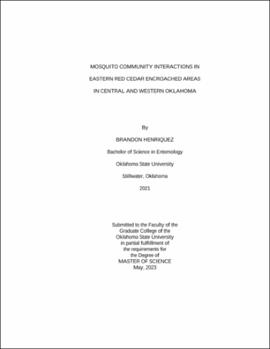| dc.contributor.advisor | Noden, Bruce | |
| dc.contributor.author | Henriquez, Brandon | |
| dc.date.accessioned | 2023-08-25T20:06:06Z | |
| dc.date.available | 2023-08-25T20:06:06Z | |
| dc.date.issued | 2023-05 | |
| dc.identifier.uri | https://hdl.handle.net/11244/338922 | |
| dc.description.abstract | The most important mosquito-borne virus in the United States is West Nile Virus (WNV) with the highest incidence of neuroinvasive disease in the Central Plains region. While much is known regarding the epidemiology of WNV transmission, the influence of landscape on the ‘nidus’ of infection requires further study. One important regional change involves the woody plant encroachment (WPE) by eastern red cedar (ERC) (Juniperus virginiana) at 5-7 times faster than other regions. Changes produced by this invasive tree are occurring on an ecosystem level, providing productive habitats for specific disease vectors. While more mosquitoes are collected in ERC compared with other habitats, there are specific questions related to host-mosquito interactions as well as habitat usage by mosquitoes in ERC-encroached areas. To address these questions, two studies were developed: The first main study focused on the hosts that mosquitoes collected in ERC-encroached areas are feeding on. The second study focused on specific habitats within ERC-encroached areas that are preferred by specific mosquito species. In 2021, 3,187 mosquitoes were collected. 95 blood-fed mosquitoes of 14 different species were identified that had fed on 12 different hosts, the majority being white tailed deer, cattle, horses, and only one avian species. We identified blood-fed mosquitoes that had flown up to 1200m into ERC-encroached areas. Additionally, Anaplasma platys was detected in the blood of 5 mosquitoes that had fed on WTD. In 2022, 3,248 mosquitoes were collected of which 3 pools were infected with WNV. Significantly more Ae. albopictus were collected inside ERC-encroached areas compared with outside and nearby grassland while more Ps. columbiae were collected in grassland compared with any ERC habitat. While not significant at the model level, the abundance of Cx. tarsalis, Cx. erraticus and An. punctipennis was all significantly higher outside of ERC-encroached areas than in grassland traps with no difference between outside and inside ERC traps. Together, these studies identified important relationships between specific mosquito species and hosts in the vicinity of ERC-encroached areas. These aspects become important from a public health perspective when the focus shifts from rural to urban areas where ERC is encroaching in the region. | |
| dc.format | application/pdf | |
| dc.language | en_US | |
| dc.rights | Copyright is held by the author who has granted the Oklahoma State University Library the non-exclusive right to share this material in its institutional repository. Contact Digital Library Services at lib-dls@okstate.edu or 405-744-9161 for the permission policy on the use, reproduction or distribution of this material. | |
| dc.title | Mosquito community interactions in eastern red cedar encroached areas in central and western Oklahoma | |
| dc.contributor.committeeMember | Talley, Justin | |
| dc.contributor.committeeMember | Loss, Scott | |
| osu.filename | Henriquez_okstate_0664M_18135.pdf | |
| osu.accesstype | Open Access | |
| dc.type.genre | Thesis | |
| dc.type.material | Text | |
| dc.subject.keywords | bloodmeal identification | |
| dc.subject.keywords | eastern red cedar | |
| dc.subject.keywords | mosquitoes | |
| dc.subject.keywords | Oklahoma | |
| dc.subject.keywords | West Nile virus | |
| dc.subject.keywords | woody plant encroachment | |
| thesis.degree.discipline | Entomology and Plant Pathology | |
| thesis.degree.grantor | Oklahoma State University | |
